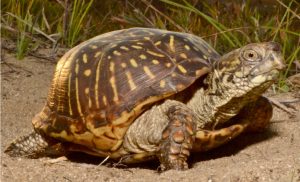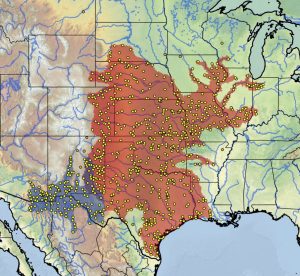Terrapene ornata, 126
Terrapene ornata (Agassiz 1857) –
Ornate Box Turtle, Plains Box Turtle, Western Box Turtle, Desert Box Turtle, Tortuga de Caja Ornamentada
Daniel F. Hughes1, Matthew C. Allender2, Neil P. Bernstein3,
John B. Iverson4, Cameron Kolthoff1, Bradley T. Martin5,
Walter E. Meshaka, Jr.6, and Benjamin M. Reed7
1Department of Biology, Coe College, Cedar Rapids, Iowa 52402 USA [[email protected]];
2College of Veterinary Medicine, University of Illinois Urbana-Champaign,
Urbana, Illinois 61801 USA [[email protected]];
3Department of Earth and Environmental Sciences, University of Iowa,
Iowa City, Iowa 52242 USA [[email protected]];
4Department of Biology, Earlham College, Richmond, Indiana 47374 USA [[email protected]];
5Department of Biological Sciences, University of Arkansas,
Fayetteville, Arkansas 72701 USA [[email protected]];
6Section of Zoology and Botany, The State Museum of Pennsylvania,
Harrisburg, Pennsylvania 17120 USA [[email protected]];
7Department of Biology, Washburn University, Topeka, Kansas 66621 USA [[email protected]]
Summary. – The Ornate Box Turtle, Terrapene ornata (family Emydidae), a terrestrial species of North American prairies and grasslands, is recognized by its brown to black shell with light yellow to orange radiating lines on each scute. This species inhabits mostly open, semiarid to xeric environments; forest, desert, and cropland habitats can be used, but prairies are preferred, and soft substrates are critical for burrowing and nesting behaviors. Males can be distinguished by a thickened, inwardly curved inner hindtoe and a generally smaller adult body size, reaching a maximum straight-line carapace length (SCL) of 157 mm, while females can attain 170 mm SCL, but most mean sizes of adults are <130 mm SCL. Sexual maturity is reached in males at 8–9 years and 100–109 mm SCL, while females mature at 10–11 years and 110–119 mm SCL, with some geographic variation noted for these patterns. Male home ranges are, on average, 6% larger than those of females. Home-range philopatry is common, with mean yearly overlap often exceeding 40%, and some individuals with over 80% overlap between years. Above-ground activity extends from March to November in most populations, but individuals from southern sites may be surface-active in winter months. Copulations have been observed from April to October with peaks during ingress and egress from overwintering sites. Daily activity is maximal in the morning and afternoon, with reduced mid-day activity and increased activity after rain. Males are generally more active than females, especially during mate-seeking in spring and fall. Nesting occurs seasonally from mid-May through mid-July. Clutch size ranges from 1 to 8 eggs, with most mean estimates of 2–4 eggs. Production of a second clutch within a season occurs but is uncommon, and not all females nest annually. Hatchlings typically overwinter below the nest. Peripheral populations, particularly the fragmented ones across the Upper Midwest, are the most vulnerable to extirpation. Habitat modifications, especially grassland succession to forests, prairie conversion to agriculture, and road construction, pose the primary threats to this species. Populations in the core of its range (Nebraska to Texas), are likely more stable, but poaching for illegal trade, collecting for turtle races, and vehicle collisions remain serious concerns. Conservation efforts should focus on maintaining, expanding, and properly managing prairie habitats with T. ornata, especially in the Midwest.
Distribution. – USA, Mexico. Terrapene ornata occurs in the Great Plains ecosystem throughout the central and midwestern USA with the core range from Nebraska south to Texas. In the northern reaches of the Midwest (Great Plains), the species is known from south central South Dakota, southwestern Wisconsin, and northwestern Indiana; in the eastern Midwest, it is known from southern Illinois, southwestern Indiana, eastern Iowa, Missouri, central Arkansas, and southern Louisiana; and in the west central USA, it is known from southeastern Wyoming, eastern Colorado, and southeastern Arizona. The southern extent of the species range in the USA occurs in southern Texas and along the Gulf Coast to Louisiana. In Mexico, the species is found in the northern reaches of the northern states of Chihuahua and Sonora, and its range is presumed to extend through southwestern Texas into Coahuila.
Synonymy. – Cistudo ornata Agassiz 1857, Terrapene ornata, Terrapene ornata ornata, Terrapene carolina ornata, Terrapene ornata cimarronensis Cragin 1894, Terrapene longinsulae † Hay 1908, Terrapene ornata longinsulae, Terrapene whitneyi ? Hay 1916, Terrapene ornata luteola Smith and Ramsey 1952.
Subspecies. – Two have been described, but are not currently uniformly recognized: 1) Terrapene ornata ornata (Plains or Western Box Turtle) (Agassiz 1857), distributed in the USA from South Dakota and Wisconsin in the North, Indiana in the East, Colorado in the West, and Texas to the border with Mexico in the South (possibly in Coahuila); and 2) Terrapene ornata luteola (Desert Box Turtle) Smith and Ramsey 1952, distributed in the USA from central New Mexico and western Texas to southern Arizona and in northern Mexico from the states of Chihuahua and Sonora.
Status. – IUCN 2024 Red List: Near Threatened (NT, assessed 2011). CITES: Appendix II, as Terrapene sp. (1995). NatureServe Global Conservation Status Rank: G5–Secure. USA: Arizona (Species of Greatest Conservation Need; S2—Imperiled); Arkansas (Species of Greatest Conservation Need; S2—Imperiled); Illinois (Threatened; S2—Imperiled); Indiana (Endangered; S1—Critically Imperiled); Iowa (Threatened and Species of Greatest Conservation Need; S2—Imperiled); Louisiana (S1—Critically Imperiled); South Dakota (Species of Greatest Conservation Need; S3—Vulnerable); Texas (S3—Vulnerable); Wisconsin (Endangered; S1—Critically Imperiled); Wyoming (S1—Critically Imperiled). No threatened designation exists for Colorado, Kansas, Nebraska, Missouri, New Mexico, or Oklahoma.
Citation:
Hughes, D.F., Allender, M.C., Bernstein, N.P., Iverson, J.B., Kolthoff, C., Martin, B.T., Meshaka, W.E., Jr., and Reed, B.M. Terrapene ornata (Agassiz 1857) – Ornate Box Turtle, Plains Box Turtle, Western Box Turtle, Desert Box Turtle, Tortuga de Caja Ornamentada. In: Rhodin, A.G.J., Iverson, J.B., van Dijk, P.P., Stanford, C.B., Goode, E.V., Buhlmann, K.A., and Mittermeier, R.A. (Eds.). Conservation Biology of Freshwater Turtles and Tortoises: A Compilation Project of the IUCN/SSC Tortoise and Freshwater Turtle Specialist Group. Chelonian Research Monographs 5(18):126.1–40. doi: 10.3854/crm.5.126.ornata.v1.2024; www.iucn-tftsg.org/cbftt/.
Adobe Acrobat 6.0 or later required)

Adult female Terrapene ornata ornata from Johnson County, Iowa, USA.
Photo by Daniel F. Hughes.
Distribution:
Distribution of Terrapene ornata in the USA and Mexico. Yellow dots = museum and occurrence records of native populations based on literature records (Iverson 1992; TTWG 2021; TTWG, in press); orange dots = introduced or possibly historically relict populations or individual trade or translocated specimens; colored shading = estimated historical indigenous ranges of: 1) T. o. ornata = red, and 2) T. o. luteola = blue; purple-colored overlap areas = presumptive intergrades. Distribution is based on fine-scaled GIS-defined level 12 HUCs (hydrologic unit compartments) constructed around verified localities and then adding HUCs that connect known point localities in the same watershed or physiographic region, and similar habitats and elevations as verified HUCs based on Buhlmann et al. (2009), TTWG (2017, 2021), and data from authors and other sources.









